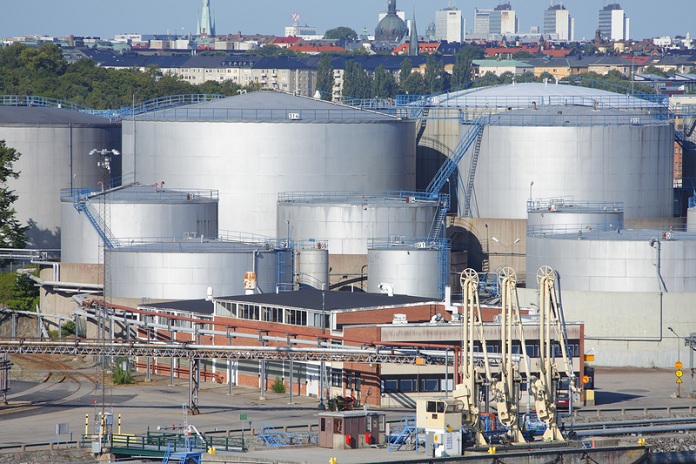DUBLIN, Aug. 1, 2023 /PRNewswire/ — The “The Global Market for Carbon Capture, Utilization and Storage (CCUS) 2023-2040” report has been added to ResearchAndMarkets.com’s offering.

The market for CO2 use is expected to remain relatively small in the near term (<$2.5 billion), but will grow in the next few years in the drive to mitigate carbon emissions from industry, potentially becoming a Trillion Dollar market.
There are currently 35 commercial facilities globally are capturing 45 Mt CO2 globally, with another 200 carbon capture facilities planned by 2030, increasing annual carbon capture volume to ~220 Mt CO2 in total. New pathways to use CO2 in the production of fuels, chemicals and building materials are driving global interest, allied to increasing backing from governments, industry and investors.
Carbon capture, utilization, and storage (CCUS) refers to technologies that capture CO2 emissions and use or store them, leading to permanent sequestration. CCUS technologies capture carbon dioxide emissions from large power sources, including power generation or industrial facilities that use either fossil fuels or biomass for fuel. CO2 can also be captured directly from the atmosphere.
If not utilized onsite, captured CO2 is compressed and transported by pipeline, ship, rail or truck to be used in a range of applications, or injected into deep geological formations (including depleted oil and gas reservoirs or saline formations) which trap the CO2 for permanent storage.
Carbon removal technologies include direct air capture (DAC) or bioenergy with carbon capture and storage (BECCS). This fast growing market is being driven by government climate initiatives and increased public and private investments. In 2022 there was over $1 billion in private investment in CCUS companies.
Climeworks, a Swiss start-up developing direct air capture (DAC) raised a $650m round in April 2022. In December 2022, Svante raised US$318 million in a Series E fundraising round. Funding has dipped in 2023, but investment remains robust.
Report contents include:
- Analysis of the global market for carbon capture, utilization, and storage (CCUS) technologies.
- Market developments, funding and investment in carbon capture, utilization, and storage (CCUS) 2020-2023.
- Analysis of key market dynamics, trends, opportunities and factors influencing the global carbon, capture utilization & storage technologies market and its subsegments.
- Market barriers to carbon capture, utilization, and storage (CCUS) technologies.
- National policies and strategies.
- Latest CCS projects updates.
- Latest developments in carbon capture, storage and utilization technologies
- Market analysis of CO2-derived products including fuels, chemicals, building materials from minerals, building materials from waste, enhanced oil recovery, and CO2 use to enhance the yields of biological processes.
- Profiles of 262 companies in Carbon capture, utilization, and storage (CCUS) including products, collaborations and investment funding.
Companies profiled include:
- Algiecel
- Aspiring Materials
- Cambridge Carbon Capture
- Carbon Engineering Ltd.
- Captura
- Carbyon BV
- CarbonCure Technologies Inc.
- CarbonOrO
- Carbon Collect
- Climeworks
- Dimensional Energy
- Dioxycle
- Ebb Carbon
- enaDyne
- Fortera Corporation
- Global Thermostat
- Heirloom Carbon Technologies
- High Hopes Labs
- LanzaTech
- Liquid Wind AB
- Lithos
- Living Carbon
- Mars Materials
- Mercurius Biorefining
- Mission Zero Technologies
- OXCUU
- Oxylum
- Paebbl
- Prometheus Fuels
- RepAir
- Sunfire GmbH
- Sustaera
- Svante
- Travertine Technologies
- Verdox
Key Topics Covered:
1 ABBREVIATIONS
2 RESEARCH METHODOLOGY
2.1 Definition of Carbon Capture, Utilisation and Storage (CCUS)
2.2 Technology Readiness Level (TRL)
3 EXECUTIVE SUMMARY
3.1 Main sources of carbon dioxide emissions
3.2 CO2 as a commodity
3.3 Meeting climate targets
3.4 Market drivers and trends
3.5 The current market and future outlook
3.6 CCUS Industry developments 2020-2023
3.7 CCUS investments
3.7.1 Venture Capital Funding
3.8 Government CCUS initiatives
3.8.1 North America
3.8.2 Europe
3.8.3 China
3.9 Market map
3.10 Commercial CCUS facilities and projects
3.10.1 Facilities
3.10.1.1 Operational
3.10.1.2 Under development/construction
3.11 CCUS Value Chain
3.12 Key market barriers for CCUS
4 INTRODUCTION
4.1 What is CCUS?
4.1.1 Carbon Capture
4.1.1.1 Source Characterization
4.1.1.2 Purification
4.1.1.3 CO2 capture technologies
4.1.2 Carbon Utilization
4.1.2.1 CO2 utilization pathways
4.1.3 Carbon storage
4.1.3.1 Passive storage
4.1.3.2 Enhanced oil recovery
4.2 Transporting CO2
4.2.1 Methods of CO2 transport
4.2.1.1 Pipeline
4.2.1.2 Ship
4.2.1.3 Road
4.2.1.4 Rail
4.2.2 Safety
4.3 Costs
4.3.1 Cost of CO2 transport
4.4 Carbon credits
5 CARBON CAPTURE
5.1 CO2 capture from point sources
5.1.1 Transportation
5.1.2 Global point source CO2 capture capacities
5.1.3 By source
5.1.4 By endpoint
5.2 Main carbon capture processes
5.2.1 Materials
5.2.2 Post-combustion
5.2.3 Oxy-fuel combustion
5.2.4 Liquid or supercritical CO2: Allam-Fetvedt Cycle
5.2.5 Pre-combustion
5.3 Carbon separation technologies
5.3.1 Absorption capture
5.3.2 Adsorption capture
5.3.3 Membranes
5.3.4 Liquid or supercritical CO2 (Cryogenic) capture
5.3.5 Chemical Looping-Based Capture
5.3.6 Calix Advanced Calciner
5.3.7 Other technologies
5.3.7.1 Solid Oxide Fuel Cells (SOFCs)
5.3.7.2 Microalgae Carbon Capture
5.3.8 Comparison of key separation technologies
5.3.9 Technology readiness level (TRL) of gas separation technologies
5.4 Opportunities and barriers
5.5 Costs of CO2 capture
5.6 CO2 capture capacity
5.7 Bioenergy with carbon capture and storage (BECCS)
5.7.1 Overview of technology
5.7.2 Biomass conversion
5.7.3 BECCS facilities
5.7.4 Challenges
5.8 Direct air capture (DAC)
5.8.1 Description
5.8.2 Deployment
5.8.3 Point source carbon capture versus Direct Air Capture
5.8.4 Technologies
5.8.4.1 Solid sorbents
5.8.4.2 Liquid sorbents
5.8.4.3 Liquid solvents
5.8.4.4 Airflow equipment integration
5.8.4.5 Passive Direct Air Capture (PDAC)
5.8.4.6 Direct conversion
5.8.4.7 Co-product generation
5.8.4.8 Low Temperature DAC
5.8.4.9 Regeneration methods
5.8.5 Commercialization and plants
5.8.6 Metal-organic frameworks (MOFs) in DAC
5.8.7 DAC plants and projects-current and planned
5.8.8 Markets for DAC
5.8.9 Costs
5.8.10 Challenges
5.8.11 Players and production
5.9 Other technologies
5.9.1 Enhanced weathering
5.9.2 Afforestation and reforestation
5.9.3 Soil carbon sequestration (SCS)
5.9.4 Biochar
5.9.5 Ocean Carbon Capture
5.9.5.1 Ocean fertilisation
5.9.5.2 Ocean alkalinisation
6 CARBON UTILIZATION
6.1 Overview
6.1.1 Current market status
6.1.2 Benefits of carbon utilization
6.1.3 Market challenges
6.2 Co2 utilization pathways
6.3 Conversion processes
6.3.1 Thermochemical
6.3.1.1 Process overview
6.3.1.2 Plasma-assisted CO2 conversion
6.3.2 Electrochemical conversion of CO2
6.3.2.1 Process overview
6.3.3 Photocatalytic and photothermal catalytic conversion of CO2
6.3.4 Catalytic conversion of CO2
6.3.5 Biological conversion of CO2
6.3.6 Copolymerization of CO2
6.3.7 Mineral carbonation
6.4 CO2-derived products
6.4.1 Fuels
6.4.1.1 Overview
6.4.1.2 Production routes
6.4.1.3 Methanol
6.4.1.4 Algae based biofuels
6.4.1.5 CO2-fuels from solar
6.4.1.6 Companies
6.4.1.7 Challenges
6.4.2 Chemicals
6.4.2.1 Overview
6.4.2.2 Scalability
6.4.2.3 Applications
6.4.2.4 Companies
6.4.3 Construction materials
6.4.3.1 Overview
6.4.3.2 CCUS technologies
6.4.3.3 Carbonated aggregates
6.4.3.4 Additives during mixing
6.4.3.5 Concrete curing
6.4.3.6 Costs
6.4.3.7 Companies
6.4.3.8 Challenges
6.4.4 CO2 Utilization in Biological Yield-Boosting
6.4.4.1 Overview
6.4.4.2 Applications
6.4.4.3 Companies
6.5 CO2 Utilization in Enhanced Oil Recovery
6.5.1 Overview
6.5.1.1 Process
6.5.1.2 CO2 sources
6.5.2 CO2-EOR facilities and projects
6.5.3 Challenges
6.6 Enhanced mineralization
6.6.1 Advantages
6.6.2 In situ and ex-situ mineralization
6.6.3 Enhanced mineralization pathways
6.6.4 Challenges
7 CARBON STORAGE
7.1 CO2 storage sites
7.1.1 Storage types for geologic CO2 storage
7.1.2 Oil and gas fields
7.1.3 Saline formations
7.2 Global CO2 storage capacity
7.3 Costs
7.4 Challenges
8 COMPANY PROFILES
For more information about this report visit https://www.researchandmarkets.com/r/rizf1f
About ResearchAndMarkets.com
ResearchAndMarkets.com is the world’s leading source for international market research reports and market data. We provide you with the latest data on international and regional markets, key industries, the top companies, new products and the latest trends.
Media Contact:
Research and Markets
Laura Wood, Senior Manager
[email protected]
For E.S.T Office Hours Call +1-917-300-0470
For U.S./CAN Toll Free Call +1-800-526-8630
For GMT Office Hours Call +353-1-416-8900
U.S. Fax: 646-607-1907
Fax (outside U.S.): +353-1-481-1716
Logo: https://mma.prnewswire.com/media/539438/Research_and_Markets_Logo.jpg
SOURCE Research and Markets

Featured image: Depositphotos © Brett Critchley















